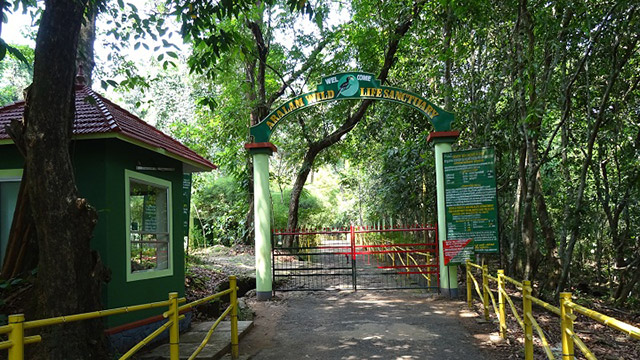
Aralam Wildlife Sanctuary

Aralam Wildlife Sanctuary
|
For Prelims: Aralam Wildlife Sanctuary (Drainage,Vegetation,Flora,Fauna,) For mains paper 3 :Wildlife Sanctuary,Western Ghats(Significance,Committees) |
Why in the news?
Recently, suspected Maoists reportedly opened fire at Forest Department watchers at the Aralam Wildlife Sanctuary in Kannur, Kerala.
About Aralam Wildlife Sanctuary:
- It is located on the western slopes of the Western Ghats.
- It is the northernmost wildlife sanctuary in Kerala and was established in 1984.
- It is contiguous with Wayanad-Brahmagiri, Wayanad's northern slopes, and the Protected Areas of Karnataka State, namely the Brahmagiri Wildlife Sanctuary and also the forests of Coorg.
- The highest peak in this sanctuary is Katti Betta.
- It is the only protected area of the West Coast Tropical Evergreen Forest of Dipterocarpus-Mesua- Palaquium type.
Drainage:
- The Cheenkannipuzha / Cheenkanni River forms the main drainage system on the southern side.
- Narikkadavuthodu, Kurukkathodu and Meenumuttithodu from the northern upper reaches, flow southwards to join Cheenkannipuzha.
- The river Cheenkani flows through this wildlife sanctuary.
Vegetation: Forest coast tropical evergreen and west coast semi evergreen forests are predominant here.
Flora: The common trees in the semi evergreen areas are Cinnamomum Zeylanicum, Hopea parviflora, Largestroemia lanceolata, Xyliaxylocarpa, Mallotus and Philippinensis.
Fauna: Deer, boar, elephant, and bison are quite common. Leopards, jungle cats and various types of squirrels are sighted here.
What is a Wildlife Sanctuary?
- A sanctuary is defined as an area of sufficient ecological, faunal, floral, geomorphological, natural, or zoological significance.
- It was established to protect, propagate, or develop wildlife or its environment. Certain rights of people living within the Sanctuary may be granted.
- These areas are enhanced by dense forests, large rivers, and high mountains.
- Wildlife Sanctuaries of India have a unique global status because they have the world's second-largest biodiversity base. These tranquil and peaceful wildlife preserves are home to a variety of rare animals and bird species.
- Furthermore, before finally notifying the Sanctuary, the Collector may, in consultation with the Chief Wildlife Warden, allow the continuation of any person's right in or over any land within the Sanctuary during the settlement of claims.
- There are 565 existing wildlife sanctuaries in India, covering an area of 122560.85 km2, or 3.73 percent of the country's geographical area.
Western Ghats
- The Western Ghats are a 1600 km long mountain chain along the west coast of India running from the river Tapi in the north to Kanyakumari in the south.
- They pass through States of Gujarat, Maharashtra, Goa, Karnataka, Kerala and Tamil Nadu (6 in number). They are known by various regional names like Sahyadri, Nilgiris etc.
- Western Ghats have a tropical humid climate .The western side of the Ghat receives more rainfall than the eastern side due to windward effect.
- Western Ghats was declared as a world heritage site in 2012 by the United Nations Education, Scientific and Cultural Organisation (UNESCO).
Significance
- Western ghats feed a large number of perennial rivers of peninsular India including the three major eastward-flowing rivers Godavari, Krishna, and Kaveri. The peninsular India receives most of their water supply from rivers originating in the Western Ghats.
- The Western Ghats influence the Indian monsoon weather patterns .They are the reason for heavy rainfall along the western coast.
- Western Ghats with their forest eco systems sequester large amount of carbon.It is estimated that they neutralize around 4 million tonnes of carbon every year- around 10% of emissions neutralized by all Indian forests
- Western Ghats are one of the eight biodiversity hotspots of the world.
- The Western Ghats have high levels of plant and animal endemism . It is estimated that 52% of tree species and 65% of amphibians found in western Ghats are endemic.
Committees
Gadgil Committee Report, 2011:
The Ministry of Environment & Forests had constituted the Western Ghats Ecology Expert Panel (WGEEP) under the Chairmanship of Prof Madhav Gadgil in 2010 to primarily demarcate ecologically sensitive areas in Western Ghats and recommend measures for management of these ecologically sensitive areas.
Kasturirangan Committee 2012:
The Environment Ministry then constituted a High-Level Working Group on Western Ghats under Kasturirangan to “examine” the Gadgil Committee report in a “holistic and multidisciplinary fashion in the light of responses received” from states, central ministries and others.
Source:The hindu